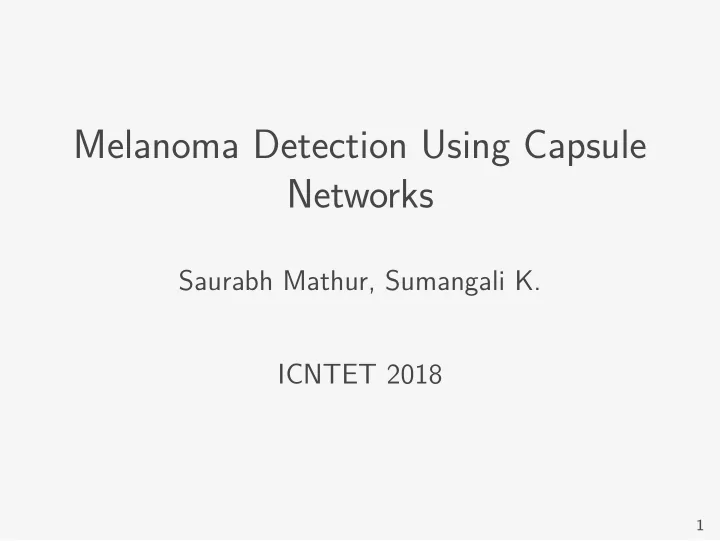

Melanoma Detection Using Capsule Networks Saurabh Mathur, Sumangali K. ICNTET 2018 1
Melanoma Deadliest type of skin cancer. Responsible for 75% of all skin cancer deaths. Caused by overexposure to UV Radiation. 2
Dermoscopy Non-invasive skin imaging technique. Provides magnifjed image of given region of skin. Images assessed by dermatologists to detect melanoma. 3
Problem Statement Dermatologist assessment of dermoscopy assessment is slow and costly. 4
Proposed Solution Automate the assessment of dermoscopy images for faster and cheaper melanoma detection. Train a classifjer on a database of dermoscopy images having labels {malignant, benign}. 5
Related Work Tommasi(2006)[5], to overcome shortcomings of CNNs CapsNet Capsule Network Model proposed Sabour(2017)[3] ISIC Dataset Codella(2017)[1] feature engineering First attempts at Melanoma Detection by Stanley(2007)[4] signifjcantly Reference crease the chances of a patient’s survival in- can melanoma of detection Early Freedberg(1999)[2] Contribution 6
ISIC Dataset - Malignant Figure: Examples of malignant skin lesion dermoscopy images 7
ISIC Dataset - Benign Figure: Examples of benign skin lesion dermoscopy images 8
Challenges ISIC dataset is not balanced (only 7% images for malignant) Occlusions in the form of hair, veins, marks on the skin and equipment related noise. Variations in size, shape, texture, and color for lesions. 9
Dataset used in experiments Derived by balancing the classes in the ISIC dataset. Consists of 1,083 benign and 1,083 malignant dermoscopy images. 10 Each RGB image is resized to 32 × 32.
Model Architecture - CapsNet Figure: CapsNet Architecture for digit classifjcation 11
Results Table: Comparision of models on test data Model Accuracy Specifjcity Sensitivity Logistic Regression 66.89% 60.70% 90.10% Capsule Network 74.69% 75.37% 73.98% 12
Results CapsNet architecture does not overfjt despite the relatively small size of training data. The model has higher specifjcity and lower sensitivity than the baseline. So, it has a low false negative rate. 13
Conclusion CapsNet architecture can be used for melanoma detection. 14
References I Noel C. F. Codella, David Gutman, M. Emre Celebi, Brian Helba, Michael A. Marchetti, Stephen W. Dusza, Aadi Kalloo, Konstantinos Liopyris, Nabin K. Mishra, Harald Kittler, and Allan Halpern. Skin lesion analysis toward melanoma detection: A challenge at the 2017 international symposium on biomedical imaging (isbi), hosted by the international skin imaging collaboration (ISIC). CoRR , abs/1710.05006, 2017. 15
References II K. A. Freedberg, Alan Geller, D. R. Miller, R. A. Lew, and H. K. Koh. Screening for malignant melanoma: A cost-efgectiveness analysis. Archives of dermatology , 143 1:21–8, 1999. Sara Sabour, Nicholas Frosst, and Geofgrey E. Hinton. Dynamic routing between capsules. In NIPS , 2017. 16
References III R. Joe Stanley, William V. Stoecker, and Randy H. Moss. A relative color approach to color discrimination for malignant melanoma detection in dermoscopy images. Skin research and technology : offjcial journal of International Society for Bioengineering and the Skin (ISBS) [and] International Society for Digital Imaging of Skin (ISDIS) [and] International Society for Skin Imaging , 13 1:62–72, 2007. Tatiana Tommasi, Elisabetta La Torre, and Barbara Caputo. Melanoma recognition using representative and discriminative kernel classifjers. In CVAMIA , 2006. 17
Recommend
More recommend